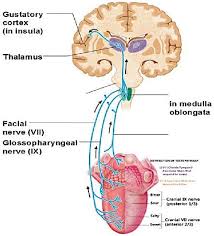 The taste pathway involves a series of neural circuits that transmit gustatory information from the taste receptor cells (TRCs) on the tongue to the brain.
The taste pathway involves a series of neural circuits that transmit gustatory information from the taste receptor cells (TRCs) on the tongue to the brain.
The process begins with the detection of taste stimuli by specialized TRCs located in the taste buds.
These cells respond to the five basic taste qualities: sweet, sour, bitter, salty, and umami.
Upon activation, TRCs release neurotransmitters that stimulate afferent gustatory nerve fibers.
Gustatory nerve fibers are part of the cranial nerves VII (facial), IX (glossopharyngeal), and X (vagus), which convey taste information to the brainstem.
These signals are relayed to the nucleus of the solitary tract (NST) in the medulla.
From the NST, taste information is transmitted directly to the thalamus.
The thalamic relay for taste is the ventral posteromedial nucleus (VPM), which then projects to the primary gustatory cortex located in the insula and frontal operculum.
In the insular cortex, taste information is processed to the perception of taste quality, intensity, and hedonic value.
The orbitofrontal cortex (OFC) additionally integrates this information with other sensory inputs, such as olfactory and visual cues, to modulate food reward and appetite.
The taste pathway is essential for the evaluation of food’s nutritional content and the initiation of appropriate feeding behaviors, as well as for the avoidance of potentially harmful substances.
